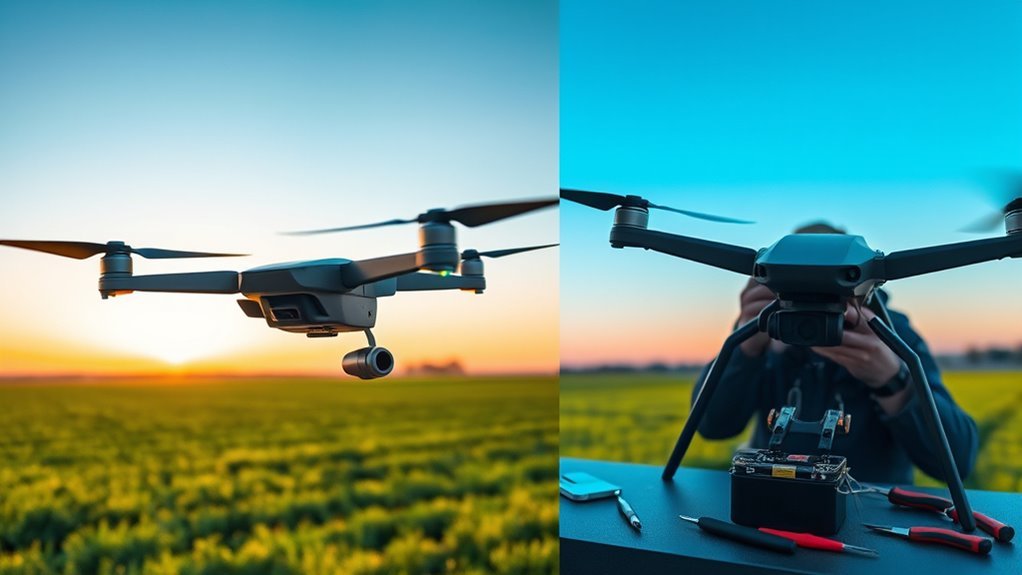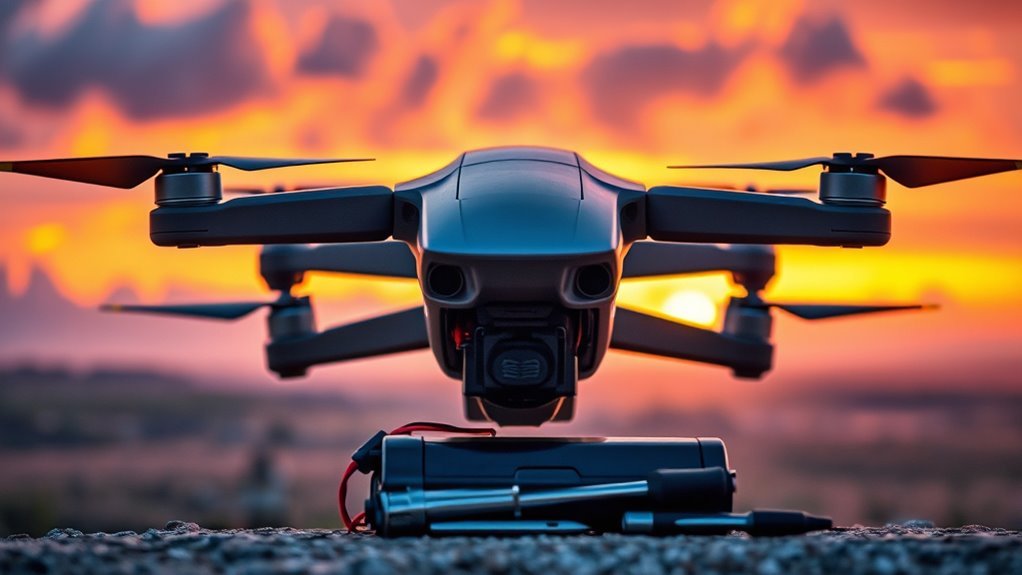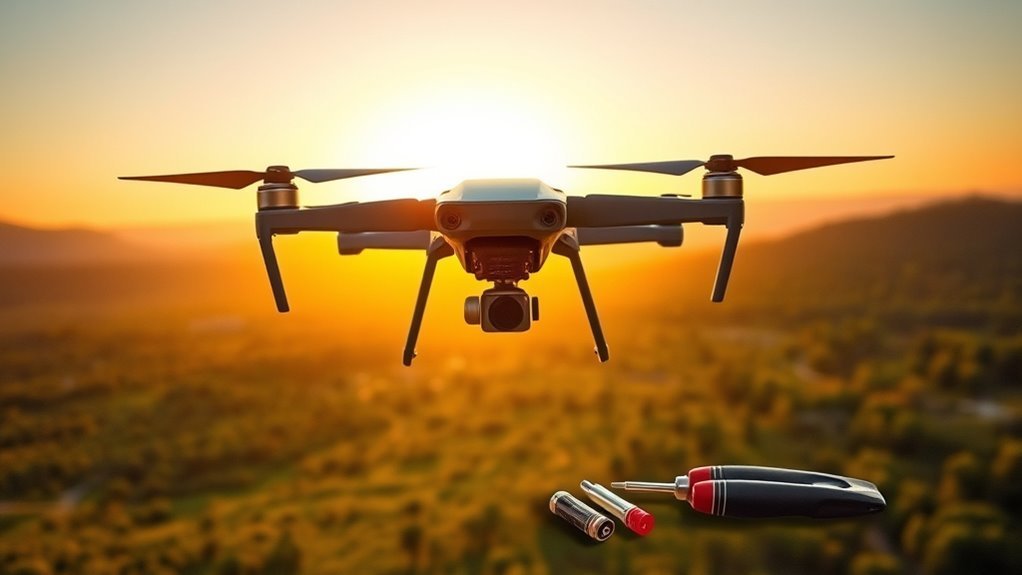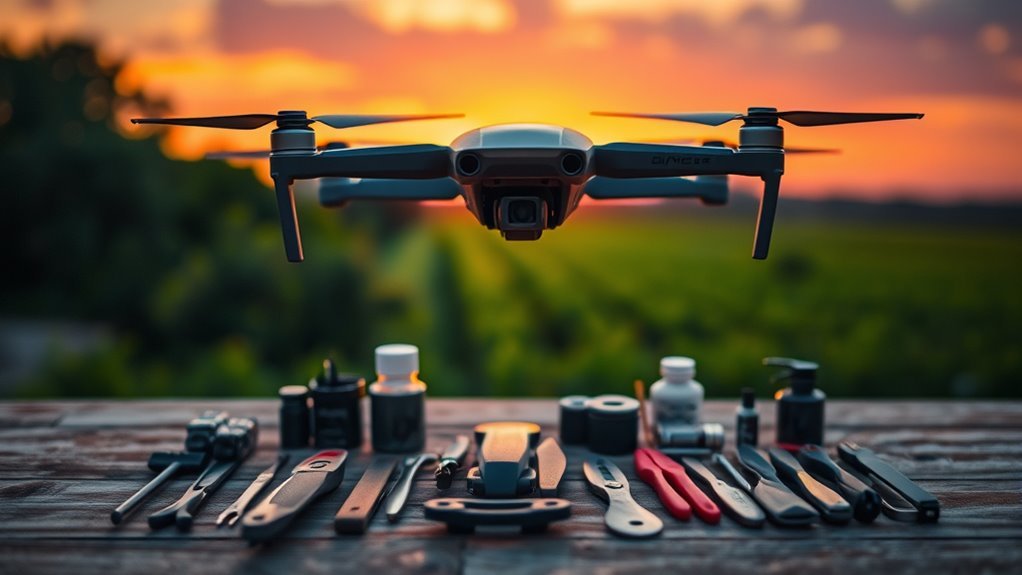You can expect your drone to last between 1,000 to 5,000 flight hours, varying by consumer or professional grade and usage intensity. Environmental factors like temperature, moisture, and flight frequency critically affect durability, while battery health determines consistent performance. Routine maintenance, timely upgrades, and proper storage—including controlled battery charge and clean, dry environments—significantly extend lifespan. Understanding these technical nuances allows you to optimize drone longevity and operational reliability—key insights await that will refine your drone care strategy.
Typical Lifespan of Consumer and Professional Drones

While the lifespan of drones varies considerably based on usage and maintenance, consumer drones typically last between 1,000 to 2,000 flight hours, whereas professional models can exceed 5,000 hours under ideal conditions. You’ll find that advances in drone technology have enhanced component durability and system reliability, extending operational longevity. However, staying compliant with flight regulations is essential, as restrictions on flight duration and conditions indirectly influence wear and tear by limiting operational stress. By understanding these parameters, you can optimize your drone’s functional period without compromising safety or legal adherence. Whether you seek recreational freedom or professional utility, recognizing the typical lifespan helps you plan maintenance cycles and replacements effectively, ensuring your drone remains a dependable tool for exploration and innovation.
Key Factors That Affect Drone Durability

Because environmental exposure and operational stress directly impact drone components, understanding the key factors that affect drone durability is essential for maximizing lifespan. You need to evaluate weather conditions carefully; extreme temperatures, moisture, and dust accelerate wear on motors and electronics. Regular exposure to high humidity or rain can corrode critical parts if your drone isn’t properly sealed. Flight frequency also plays a significant role—higher usage increases mechanical fatigue and strains the structural integrity of propellers and frames. Additionally, abrupt maneuvers and crashes amplify stress on joints and sensors, reducing durability. By monitoring these factors and adjusting your flying habits accordingly, you preserve your drone’s mechanical health and maintain longer operational freedom without premature failures.
How Battery Life Influences Overall Drone Longevity

You’ll find that battery capacity directly affects your drone’s flight duration and performance consistency, which in turn impacts its overall lifespan. How you manage charging habits—such as avoiding overcharging or deep discharges—plays an essential role in preserving battery health. Optimizing these factors guarantees your drone maintains operational efficiency over time.
Battery Capacity Impact
Battery capacity plays a critical role in determining a drone’s operational lifespan and overall longevity. The battery’s ability to store and deliver energy directly affects how long you can fly and how often you’ll need to recharge, which impacts the battery lifespan and total charging cycles. A higher capacity battery means extended flight times but also requires careful management to maintain efficiency and health.
Consider these factors:
- Higher capacity batteries generally have more charging cycles before degradation.
- Capacity loss reduces flight duration, limiting operational freedom.
- Balancing weight and capacity is essential for peak performance.
- Proper storage and usage help preserve capacity over time.
Understanding battery capacity enables you to maximize your drone’s freedom and longevity effectively.
Charging Habits Effects
Although ideal battery capacity is vital, your charging habits greatly influence both battery health and the drone’s overall longevity. Maintaining correct charging frequency prevents deep discharges and overcharging, both of which degrade lithium-polymer batteries rapidly. You should avoid charging after every minor battery drop; instead, initiate charging when the battery reaches about 20-30% capacity to enhance cycle life. Equally critical is adhering to the best voltage range during charging—typically around 4.2 volts per cell—since exceeding this threshold accelerates capacity loss. Using quality chargers with precise voltage regulation guarantees stable current flow, minimizing thermal stress. By controlling charging frequency and maintaining best voltage, you sustain battery efficiency, which directly extends your drone’s operational lifespan and preserves your freedom to explore longer without unexpected interruptions.
Common Causes of Drone Wear and Tear
Since drones operate in varied and often challenging environments, several factors contribute to their wear and tear over time. Understanding these wear factors is essential if you want to maintain your drone’s peak performance and freedom of flight. Environmental impacts play a significant role, as exposure to dust, moisture, and temperature fluctuations accelerates component degradation. Mechanical stress from frequent takeoffs, landings, and vibrations also wears down motors and propellers. Additionally, electromagnetic interference can affect electronic systems, leading to malfunctions. Here are the primary causes of drone wear and tear:
Drones face wear from environmental exposure, mechanical stress, and electronic interference affecting performance.
- Exposure to dust, humidity, and temperature changes
- Mechanical strain from repeated flights and vibrations
- Impact damage from collisions or rough landings
- Electronic stress due to signal interference and power surges
Being aware of these factors helps you anticipate when parts may need inspection or replacement.
Maintenance Practices to Extend Your Drone’s Life
When you regularly perform targeted maintenance, you can significantly reduce wear and extend your drone’s operational lifespan. Prioritize thorough drone cleaning to prevent dirt and debris from impairing sensors and motors. Equally important are timely software updates, which optimize flight control systems and patch vulnerabilities, ensuring reliable performance.
| Maintenance Task | Emotional Impact |
|---|---|
| Drone Cleaning | Confidence in smooth flights |
| Software Updates | Assurance of peak efficiency |
| Regular Inspections | Freedom from unexpected failures |
Upgrading Parts to Keep Your Drone Flying Longer
To keep your drone operational beyond its factory lifespan, you’ll need to replace essential components like batteries, motors, and propellers as they degrade. Upgrading to higher-performance parts can also enhance flight efficiency and stability. Understanding which parts to prioritize guarantees you invest in upgrades that extend both functionality and reliability.
Essential Component Replacements
Replacing key components at regular intervals is critical for maintaining peak drone performance and extending its operational lifespan. You’ll want to adhere to essential component upgrades and replacement timelines to guarantee your drone remains reliable and efficient. Key parts degrade with use, affecting flight stability and safety, so timely replacement is non-negotiable.
Focus on these components for maximum longevity:
- Batteries: Replace based on charge cycles to prevent capacity loss and sudden failures.
- Propellers: Inspect regularly; replace at first sign of cracks or warping to maintain lift and control.
- Motors: Monitor for wear and unusual noise; replace when efficiency drops or vibrations increase.
- Electronic Speed Controllers (ESCs): Upgrade or replace if overheating or erratic motor response occurs.
Performance-Boosting Upgrades
Although routine maintenance is essential, upgrading specific drone components can greatly enhance performance and extend flight duration. You’ll want to focus on performance enhancements like high-capacity batteries, efficient brushless motors, and lightweight carbon fiber frames. These aftermarket mods reduce weight and energy consumption, directly boosting flight time and responsiveness. Upgrading propellers to aerodynamic, low-drag designs also optimizes thrust-to-power ratios, allowing you to push your drone farther with less battery drain. Precision in selecting compatible parts guarantees system reliability and prevents undue stress on the drone’s electronics. By strategically incorporating these aftermarket mods, you not only improve endurance but also maintain the drone’s agility and control, granting you the freedom to explore longer and more demanding flights without compromise.
Best Storage Tips to Preserve Drone Components
When you’re not flying your drone, how you store its components greatly affects their longevity and performance. Ideal storage conditions minimize wear and prevent degradation of sensitive parts. Prioritize thorough component cleaning before storage to remove dust, moisture, and residues that cause corrosion or malfunction over time. Maintain a stable, dry environment with controlled temperature to avoid thermal stress and moisture buildup. Use protective cases designed to cushion impacts and block contaminants.
- Store batteries at 40-60% charge in a cool, dry place to prevent capacity loss.
- Keep propellers detached and secured to avoid warping.
- Use silica gel packs to absorb residual moisture.
- Avoid direct sunlight to prevent UV damage to plastic and electronic parts.
Adhering to these technical guidelines preserves your drone’s readiness and extends its operational freedom.

